© FCI


1932, Firenze, very first international cynological congress
© FCI


1932, Firenze, the Duke of Aoste at the FCI General Assembly
1932, the very first international cynological congress is conducted in Firenze
(Italy) and organised by the ENCI (Ente Nazionale della Cinofilia Italiana)
The FCI then includes twelve members (seven federated and 5 associated). On the
occasion of the General Assembly, held in Firenze too, the Baron Houtart expresses
his warm thanks to the Union Cynologique Saint-Hubert (Belgium) for the "administrative
services of the UCSH on the shoulders of which lies all the weight of our Federation".
The number of CACIB shows this year reaches 19 (with a total of 672 CACIB awarded)
and 21 titles of CIB are confirmed by the FCI. Parallel to this, 26 CACIT trials
are organised and 3 titles of CIT are processed. At the end of the session and
for the first time, a Swiss is elected President: Mr Scheitlin. On the occasion
of the subsequent Assembly in Zürich, it is resolved that from January 1st,
1934,
a dog has to be 15 (vs 18 in earlier times) months to be entered in the open class.
Under HH Princess of Monaco, the FCI members meet in 1934 in Monaco, for their annual
General Assembly and for the second cynological congress.
© FCI
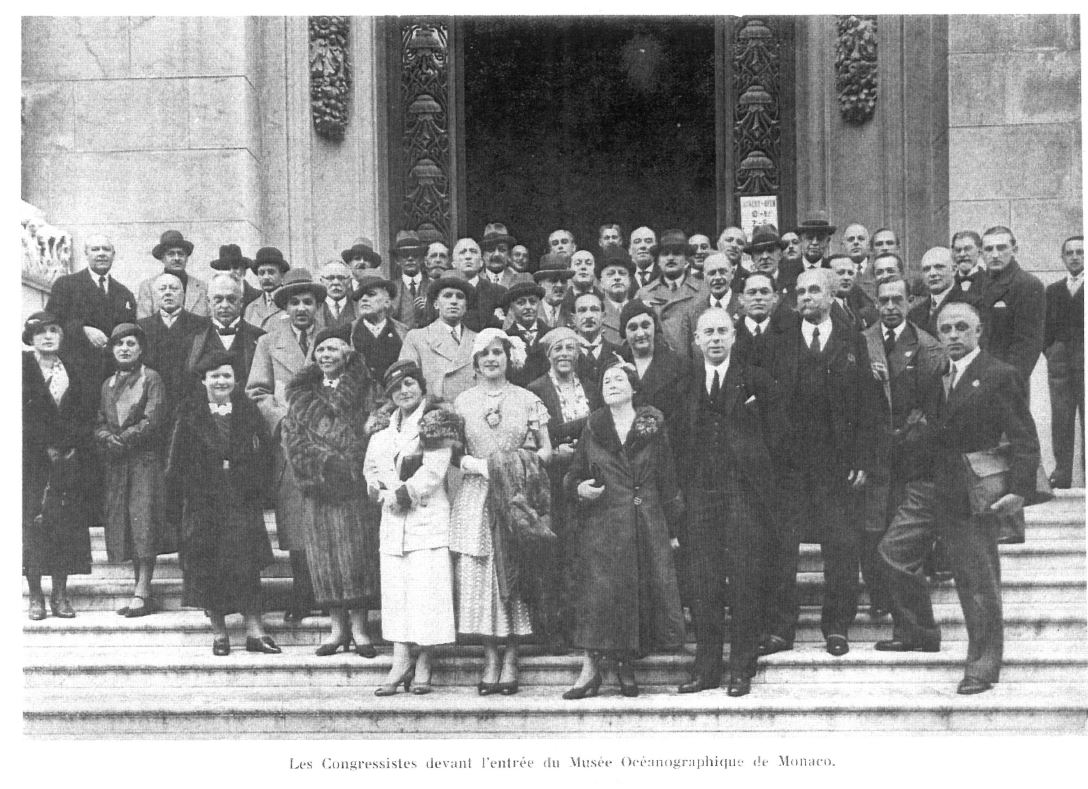

1934, the participants in the Congress, Monaco
© FCI
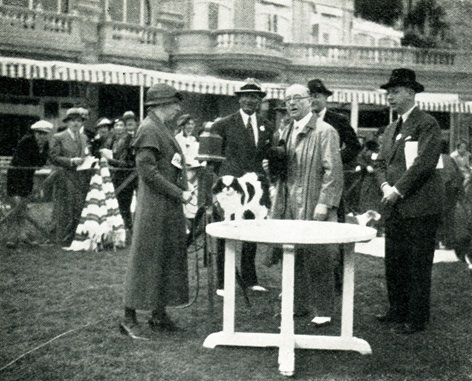

1934, judging at the dog show in Monaco
© FCI


1934, a view of the dog show, Monaco
© FCI


1935, cover of the proceedings of the Cynological Congress, Francfort
On this occasion, Denmark becomes a federated member of the FCI. Germany, Czechoslovakia,
Brazil and Romania get the status of associated members. The number of shows keeps
increasing and a new title is created, which still exists today although not often
awarded: the cumulative title of “working and beauty champion”.
In the General Assembly's minutes, one can find indication of the fees for the CACIB
shows: 100 Belgas (12.5 €) for shows allotted “by right” to a member or 60 Belgas
(7.5 €) for those allotted by “delegation”. The right to award the CACIT at a trial
amounts to 20 Belgas (2.5 €). As one can see, at that time, the fee charged for
shows does not yet apply to every dog appearing in the catalogue; that decision
will indeed be made later.
On 20th February 1935, a cooperation convention is signed by the FCI
and the Kennel
Club (England). Not less than 31 CACIB shows and 50 CACIT events have been organised
in 1934. The figures keep increasing. The 3rd International Cynological
Congress
takes place in Francfort.
© FCI


1935, the participants in the FCI General Assembly, Francfort
© FCI

At the General Assembly, the Baron Houtart informs that he's resigning. He is replaced
by Mr Du Pré who will act as Secretary General until 1936. The General Assembly
elects the Count of Moltke as President and the next Assembly is celebrated in Copenhagen
where Yugoslavia becomes a federated member. At that period, the FCI has 14 federated
and 7 associated members.
© Marie Luna Durán


FCI Headquarters, 1936
From 1937 until 1939, the Count t’Serclaes de Sommersom will be the FCI Secretary
General. In this period, Latvia and Lithuania will get the status of associated
member and a proposal to have the German language recognised as an official FCI
language is turned down. French remains the only language used in the FCI. A fourth
cynological congress takes place in Paris in 1937 in the frame of the “Exposition
Universelle”.
© Marie Luna Durán


FCI Headquarters, 1948
A last General Assembly will be held in 1939 in Stockholm; then the FCI activities
logically decrease without however, and surprisingly, being totally interrupted.
No General Assembly is held during the war period.
© Marie Luna Durán
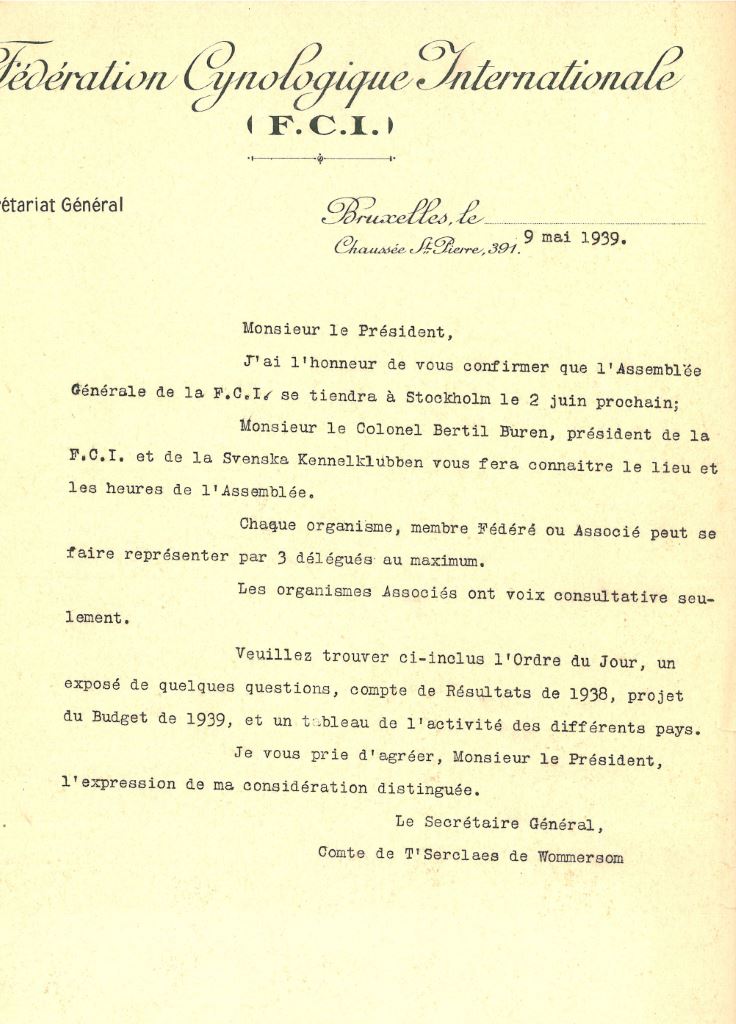

1939, invitation to the FCI General Assembly, Stockholm
The world cynological authorities and leaders have to wait until 1947 to meet again,
in Brussels. That year, it is pointed out that during the year 1946 and until the
Assembly takes place, an amazing - considering the overall context - number of 31
CACIB shows and 39 CACIT trials took place, showing how passionate dog lovers remained
despite the tragic years that they experienced. This clearly shows that cynological
activities never totally ended as explained earlier. France has organised 6 shows
for a total of 4,479 dogs, followed by Italy, 5 shows, and the Netherlands with
4 shows. The FCI Office also got on the same train as they managed to confirm 11
titles of CIB and the UCRSH informs that not less than 1,858 kennel names were registered.
The year 1949 has a very particular meaning and flavour for the 22 members of the
FCI attending the General Assembly as they gathered in Paris under Mr Guilbert as
President and were greeted by the President of the French Republic, Mr Vincent Auriol,
at the Elysée.
© FCI


1949, programme of the FCI General Assembly in Paris
At the 1950 Assembly held in Amsterdam, the members decide that a fee of 1 BEF (0.025
€) will be charged per dog appearing in the catalogue! That resolution still applies
today and remains the major source of revenues of the FCI.
At that period, the texts also refer to a fee due to the FCI per dog registered
in the stud-books. A total of 38 CACIB shows are reported to have been organised,
while 30 titles of CIB and 1 CIT have been confirmed. Another major decision is
made: a dog having a pedigree with 3 generations registered with FCI recognised
stud-books is considered to be pure-bred. In addition, the FCI can only confirm
the CACIB’s awarded to dogs whose genealogy is confirmed to be complete by the canine
organisation where they are registered. As one can see, the principles
applied
nowadays are strongly rooted in history.
© FCI


1950 General Assembly, Amsterdam, FCI Board. From left to right: J. Rothea (FR), Baron Houtart (BE, Secretary General), Dr W. Hirschfeld (NL, President), Dr Solaro (IT)
© FCI
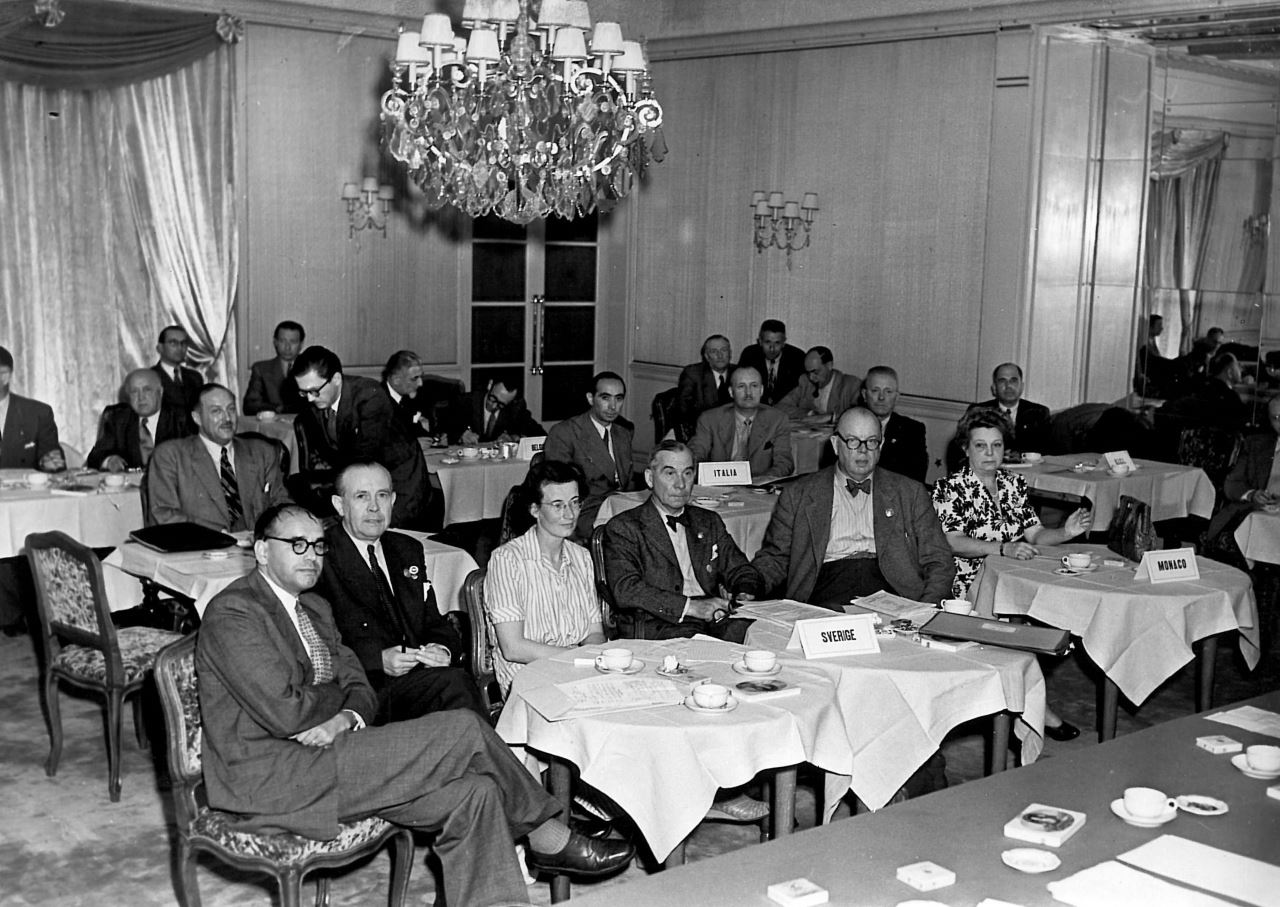

1950 General Assembly, Amsterdam, a view of the participants
© FCI

© FCI

© FCI

© FCI
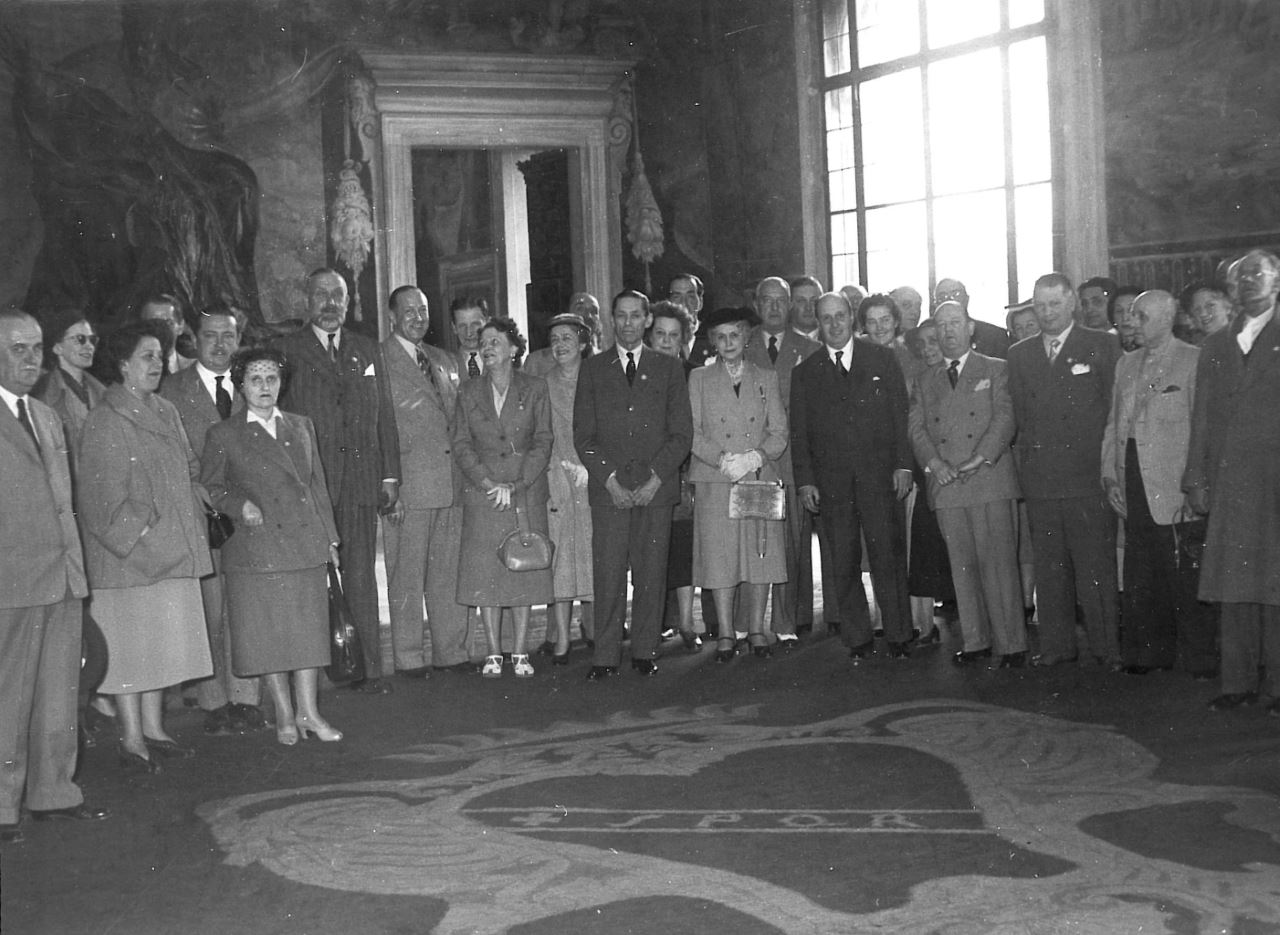

1951, FCI General Assembly, Rome, a view of the participants
© FCI


Mr Ch. Gendebien (BE), FCI Secretary General (1951-1969)
The following year sees a very unfortunate event: the death of Baron Houtart. He
is substituted by Mr Charles Gendebien. In Rome, on the occasion of the 1951 General
Assembly chaired by Mr Solaro, it is indicated that Germany is now represented by
a new member, the VDH, Verband für das Deutsche Hundewesen.
The year 1953 is very important for two good reasons: German becomes an official
FCI language and the FCI Offices are moved from the house of the then Secretary
General to Avenue Leopold II, 6530 Thuin (Belgium), a city where the headquarters
are still located today. From that year and for some more, a “Bulletin de la FCI”
will be published.
© FCI

© FCI


1953, FCI Bulletin
© FCI


The first FCI headquarters in Thuin
© FCI


The first FCI headquarters in Thuin
© OTT


A view of the City of Thuin
1954 is important as it means the creation of the concept of « Reserve CACIB”
awarded
in case the winning dog is too young or not pure-bred.
Dortmund and the VDH, in 1956, are the host of the FCI World Cynological Congress
in conjunction with a big dog show surprisingly called “world dog show”.
© FCI


1956, FCI World Cynological Congress, Dortmund
© FCI


1956, FCI “World Dog Show”, judges list